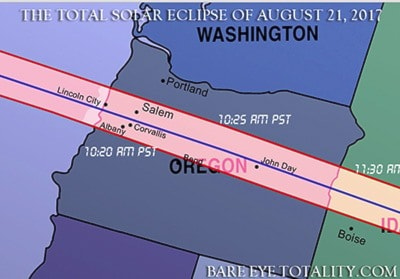What’s up in September’s night skies? An African eclipse, meteor showers, moon and planet pair-ups.
Observers in central Africa will see an annular eclipse Sept. 1. This is where the moon covers most – but not all – of the sun. In this eclipse, the moon will block only 98.7 per cent of the sun.
For the Oregon solar eclipse Aug. 21, 2017, parents and teachers need to warn children that they need to use safe solar eclipse glasses or filters on telescopes, binoculars or cameras. You can order paper glasses online or from Oak Bay’s toy shop well in time for next August. These would be a great stocking stuffer for Christmas or a birthday gift.
This total solar eclipse will follow a narrow band from Oregon to South Carolina. The path of total eclipse will be about 100 miles wide. The penumbra (partial darkness) will even be seen in Oak Bay. We’ll talk more about it as the date gets closer. Many of us will plan an overnight trip to Oregon to experience the full eclipse.
If last month’s Perseids meteor shower whetted your appetite for meteor observing, there are two minor meteor showers this month, both with about five swift and bright meteors per hour at their peak – which will be near dawn.
The first is the Aurigid shower on Sept. 1. The new moon on Sept. 1 means the sky will be nice and dark for the Aurigids. The second shower is the Epsilon Perseids on Sept. 9. The radiant is not too far from the location of last month’s Perseids in the sky over Vancouver in the north-east sky. The first quarter moon sets on Sept. 9 at midnight, just in time for the best viewing of the Perseids.
There are many nice pair-ups between the moon and planets this month. You can see the moon between Venus and Jupiter Sept. 2, and above Venus on Sept. 3, right after sunset low on the west-southwest horizon over Metchosin. There are so many great places to gather. Perhaps Gonzales Hill or Mount Tolmie.
On Sept. 15, the nearly full moon pairs with Neptune, two weeks after its opposition, when the eighth planet is closest to Earth in its orbit around the sun – in fact 2.7 billion miles distant. The moonlight may wash out the planet view, but try anyway. You may spot magnitude 7.8 Neptune with binoculars, but a telescope will show the disk and some colour. The ice giant’s colour appears a subtle bluish-grey to the eye, not the brilliant blue seen by Voyager 2’s cameras as it flew past Neptune in August 1989.
Neptune is visible all night long, rising in the east over Mount Baker and setting in the west at dawn over the Sooke Hills.
Finally, the “zodiacal light” is visible in the eastern sky over Discovery Island before sunrise.
From a dark sky, look for a faint diffuse triangle extending up from the vicinity of the sun along the ecliptic (The Salish Walk of the Planets). This effect is caused by sunlight scattered by space dust in the zodiacal cloud. The zodiacal cloud is dust found in our solar system, primarily between the sun and Jupiter. This dust originates from comets and asteroids.
Catch up on current missions to comets, Jupiter, Mars and Saturn at jpl.nasa.gov and on all of NASA’s missions at Nasa.gov. Should you wish to meet the RASCals of Cattle Point – see facebook.com/groups/VictoriaRASCals or drop by Mondays at 7:30 p.m. at Fairfield Community Centre.
Dark Skies to all friends of Cattle Point Star Park.
Summary by Bill Smith and the RASCals of Cattle Point, volunteers at Cattle Point DARK SKY Urban Star Park, from the transcript of “What’s Up in September 2016” by NASA announcer and astronomer Jane Houston Jones, with specific permission for localization to Cattle Point DARK SKY Urban Star Park and the Oak Bay News.
